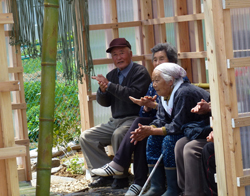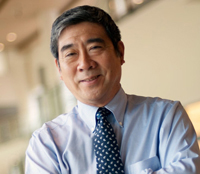MIT-Japan 3.11 Initiative Receives Grant

Residents of Baba-Nakayama temporary housing in Minami Sanriku enjoy a newly constructed garden pavilion.
THE CENTER'S MIT-JAPAN PROGRAM received a grant from The Japan Foundation's Center for Global Partnership for the MIT Japan 3.11 Initiative.
The Initiative is MIT's response to the devastating March 2011 earthquakes and tsunami in the Tohoku region of Japan. The $69,000, one-year grant will be used for planning costs connected with the creation of a symposium and a community center in Minami Sanriku, Japan, a village virtually destroyed during last year's disaster.
This multi-use interim town center will be planned in conjunction with the residents of Minami Sanriku's largest temporary housing site. The center will provide a vital gathering space for this displaced community, offer a wide range of services to the village, and help residents return to their daily routines and draw strength from each other during the rebuilding process.
Richard Samuels, director of the MIT-Japan Program, expressed his enthusiasm for the opportunity to bring political scientists, architects, and planners together in this project. Samuels is Ford International Professor of Political Science and director of the Center for Interntional Studies at MIT.
MIT is also creating a university curriculum as part of a wider effort to study and promote disaster-resilient town planning, design, and reconstruction.
Prepared by Nancy Angoff, MIT Office of Foundation Relations
Iran's Foreign and Energy Policies over the Next 25 Years

Abbas Maleki, Robert E. Wilhelm Fellow at CIS
In a May 9 seminar on Iranian energy security and its intersection with Iranian foreign policy, Abbas Maleki, former Deputy Foreign Minister of Iran (1986-1997), said he expected nuclear energy to play a relatively small role in Iran's energy future. In fact, he suggested that if the United States were to drop its objections to Iran's pursuit of nuclear technology, Iranians would probably declare that they had no real interest in such technology anyway.
Only about two percent of Iran's total energy production comes from nuclear sources, Maleki, now Associate Professor of Energy Policy at Sharif University of Technology, Tehran and a Robert E. Wilhelm Fellow at CIS, said. He added that the cost-benefit calculations for "expensive and old" nuclear technology, versus other renewable and non-renewable sources, are not favorable. Rather, Maleki sees the development of wind and solar power, and increased oil and natural gas production, as more promising avenues for the Iranian economy.
Why, then, does Iran continue to pursue nuclear technology? "This is a case of respect and pride for Iranians," Maleki said. He charged the US with upholding a double standard, allowing states such as India, Israel, and Pakistan to develop nuclear technology while sanctioning Iran for the same behavior. Because of this double standard, he said, Iranian leadership feels it must oppose American efforts.
On the other hand, Maleki categorically rejected the idea that Iran might soon develop a nuclear weapon. He noted that Ali Khamenei, the supreme leader of Iran, has declared the pursuit of nuclear weapons to be contrary to Islam, and added, "When you are the leader of a country, you cannot say something now and change it tomorrow. Because of the public, you cannot lie." Maleki also argued that the development of nuclear weapons makes no strategic sense for Iran. Iran has plenty of conventional military capability to take on near potential adversaries such as Iraq, Pakistan, and Turkey, while a handful of nuclear bombs—the likely yield of an Iranian nuclear weapons program in the short term —would provide no match for the nuclear weapons capabilities of far potential adversaries such as China, Russia, or the United States, he said.
In discussing Iranian foreign policy more generally, Maleki argued that Iran should pursue a regionalist approach, increasing engagement both with near neighbors and the regional organizations that represent their interests. Such organizations include the Economic Cooperation Organization, the Organization of Islamic Cooperation, and the Shanghai Cooperation Organization. Shifting energy demand should motivate this push toward regionalism, Maleki said. Whereas traditionally the areas of the world with the most energy supply and the most energy demand have been different—central Eurasia versus Europe and North America, respectively—now both supply and demand are becoming more concentrated in Iran's immediate vicinity.
Specifically, Maleki said there are significant opportunities for bilateral trade in petroleum products with Iraq, given that most Iraqi and Iranian oil and gas sources lie in the border region between the two states. Iran could act as a key market and conduit for Iraqi oil, he said. Iraq's prospect as an oil producer is still in doubt, but Maleki claimed that if Iraq could manage to produce three million barrels per day—a conservative estimate—it would become the second-largest oil exporter in OPEC. Maleki also spoke of several initiatives to improve the transportation of oil and gas from Iran, through its neighbors, to customers in Europe. He showed the audience four international pipelines under development, three of which are planned to run through the Middle East (the fourth would run through the Ukraine, Azerbaijan, and Georgia).
Regionalism would not come without its drawbacks, Maleki acknowledged. Chief among them would be some loss of sovereignty and some loss of cultural distinctness, he said. However, he sees the potential benefits outweighing the potential costs, particularly if Iran pursues a policy of "self-reliance" in parallel with its pursuit of regionalism.
Maleki said self-reliance requires, among other things, increasing Iranian oil production from four million barrels per day to 7.5 million barrels per day, improving Iran's indigenous capacity to train petroleum engineers and similar professionals, building up Iran's private sector as a way of skirting international sanctions on importing oil and gas from Iranian state-owned enterprises, and resolving international territorial disputes over the oil and gas resources in the Caspian Sea in a manner that provides Iran with an alternative, albeit modest, supply source. Iran has just 1 percent of the world's population but 10 percent of its proven oil reserves, and 16 percent of its proven gas reserves, he said. So there is certainly the potential for self-reliance, but challenges remain.
The tense relationship between Iran and the U.S. will create particular challenges for these development efforts, Maleki said. He noted that out of Iran's 15 neighbors, 12 have U.S. troops deployed there. Despite Iran's geographic distance from the US, he said, "When you are surrounded by the American troops, you cannot think easily about development, investment, or infrastructure."
On another recent point of tension in U.S.-Iranian relations, Maleki argued that Iran had no interest in closing the Strait of Hormuz. The strait, which carries about 16.5 million barrels per day of oil, is Iran's key naval gateway to the outside world, he said.
Nathan Black served as rapporteur for this talk.
Gradual Versus Binary Drug Licensing Process

Kenneth Oye, Associate Professor of Political Science and of Engineering Systems at MIT
A review paper published online in Clinical Pharmacology and Therapeutics promotes further exploration of adaptive licensing (AL) to identify serious safety issues earlier, improve the efficacy of drug therapies in use, and reduce the number of patients exposed to risks.
Under the present system, licensing decisions are based primarily on demonstrations of safety and efficacy of drugs in tightly controlled clinical trials using relatively homogeneous populations of patients that are free from complicating conditions. However, once approved, most drugs are used in uncontrolled settings by large heterogeneous populations of patients with confounding factors. As a consequence, it is not surprising that with some frequency projections of safety and efficacy based on such trials do not hold for the same drugs in real world use.
Hans-Georg Eichler, Kenneth Oye and colleagues review eight proposals for AL, including Health Canada's Progressive Licensing Project, the MIT Center for Biomedical Innovation's New Drug Development Paradigms, and the European Medicines Agency Road Map to 2015. In addition, the authors identify general considerations successful AL programs need to address, including acknowledgment of acceptable levels of uncertainty, improved public communication of drug safety and efficacy, increased prescription control, and additional surveillance and data collection. Finally, the authors flag unresolved issues that require further research.
This work represents an unusually integrative joint project linking MIT Center for Biomedical Innovation and the MIT Center for International Studies. The paper on AL of pharmaceuticals is part of a larger set of projects, including prior work by Lawrence McCray, Kenneth Oye and Arthur Petersen on adaptive regulation in environment, health and safety and current work by the Program on Emerging Technologies on adaptive management of risks associated with emerging technologies such as synthetic biology supported by NSF Synthetic Biology Engineering Research Center.



